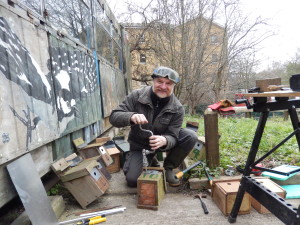
Quick! Spring is in the air, the Dunnocks are passionately singing their tuneless songs, the Great Tits are yelling Zi-Za-Zi-Za-Zi-Za endlessly, the Greenfinches are wheezing out their odd song (‘Zheee’), it’s time to fix those nestboxes. Most of those in the Gunnersbury Triangle had been “hammered” by Tits or Woodpeckers, or gnawed by squirrels. And a few had been rather roughly drilled by humans. So the warden decided that all of them should be given anti-squirrel plates; all, that is, except the Robin boxes, which have a wide rectangular opening in the front.
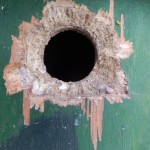
A few of the boxes seemed to have been attacked by squirrels. This one has what could be toothmarks and signs of extensive tearing of the wood outwards at a shallow angle, which looks like gnawing rather than hammering. It isn’t obvious why the basically herbivorous Grey Squirrel should do this.
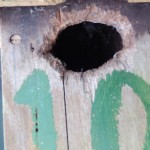
This box, on the other hand, seems to have been hammered at a sharp angle to the surface, whether by the Tits themselves (they certainly do this sometimes) or by Greater Spotted Woodpeckers preying on nests – although they mainly eat insects and seeds, they do take eggs and chicks when the opportunity arrives.
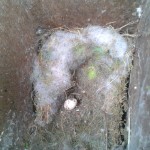
At least 4 of the nestboxes had substantial and reasonably fresh remnants of nests inside; this older one contained two long-addled tit eggs (just one shown here; it was 16 mm long) with a mixture of moss and down as insulation.
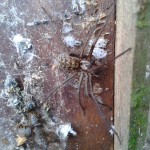
Finally, one very old nestbox, carefully engineered with beading around the hinged lid complete with little brass hooks, contained a Giant House Spider, Tegenaria, a lot of beetle pupae, and what could be Gypsy Moth pupae as well. The box was a messy tangle of thick sticky cobweb, and the spider was distinctly reluctant to leave, seeming to want to stand and fight off any intruder.
All in all, what might have seemed a mundane bit of metalwork turned out to be a day full of interesting natural history. (But the metalwork was fun, too.)

